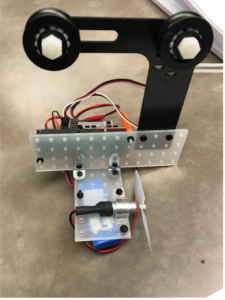The team initially started the research process with the base model AEV given by the instructors.
Model AEV
The codes used on this design can be found in the Preliminary Research and Development Code Glossary
During the Pre- R&D stage, the team conducted a concept screening and scoring lab which lead to the first individual designs made by the team members. Those sketches and screening/scoring matrices can be found in Lab 5.
Although a consensus was made when deciding what two designs to move forward with, the team’s current design is much different than the designs in the screening and scoring.
For the grant proposal, the team pitched the design of an arm that would only hold one wheel. However, this design was scrapped because it affected the balance of the AEV to be deemed efficient.
Past AEV Design Concept – Grant Proposal
The team had the opportunity to design and pitch a custom part that could potentially be funded by grant money. For this, the team created the concept of a one-wheeled AEV. The part that would specifically be pitched was an arm that supported only one wheel but still contained the holes that the reflective sensors would be attached to. The team believed that this design would eliminate mass, cost, friction, and energy as well.
However, the team did not win the grant money. Therefore, the design was abandoned. After further discussion of the design, the team felt that it was too unstable for the later parts of the final task, such as carrying the caboose. The file below is a video of that part in SolidWorks.
Past AEV Design
(Model is symmetrical from front to back)
This model is used in both the Motor Configuration Lab , Coasting v. Power Braking Lab, and Performance Test One. It is small and compact, intended to decrease the overall mass of the vehicle. The codes used with this model can be found in the Advanced Research and Development Code Glossary.
Final Design with Drawing
(Model is symmetrical left to right)
The previous model was modified to accommodate the requirement that the magnet that attached to the caboose needed to be 2 inches away from the Arduino board. Both the board and the battery were moved to the bottom of the vehicle to create free space on the sides of the AEV and to eliminate the need for the battery holder.
PDF of orthographic drawings of final design: Final drawing (1)-12fhmxw


